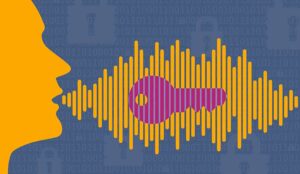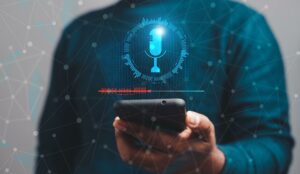Jennifer Bonacci at Talkdesk looks at what misconceptions are keeping you from implementing voice biometrics.
Despite the widespread need to protect data and implement robust fraud detection and prevention measures, using voice biometrics as part of a contact centre’s security initiative hasn’t always been widely embraced.
In fact, one can still find lingering concerns about its efficacy, reliability, and privacy protection capabilities. In this blog, we’ll address some common myths about voice biometrics technology.
5 Myths About Voice Biometrics in the Contact Centre.
Myth #1: Hackers Can Easily Trick Voice Biometrics Systems.
Voice biometrics analyzes the unique characteristics of an individual’s voice to create a voiceprint for authentication purposes. Like your fingerprint, your voiceprint is composed of multiple points (or variables) to create a holistically distinctive print.
Those variables include the form and frequencies of the sound waves produced by your vocal cord vibrations, inflection, tone, and pronunciation.
Because your voiceprint consists of multiple identifiers unique to you, imitating the sound of your voice isn’t enough to fool biometrics technology.
Furthermore, this technology can pick up on discrepancies not audible to the human ear—like the additional background noise produced if someone were to play a recording of your voice—making it extremely difficult for a hacker to try to access your data in this way.
Myth #2: Voice Biometrics Technology Comes With Significant Privacy Risks.
People have every right to safeguard their identity and understand how their personally identifiable information (PII) is protected and stored.
It’s important to note that your customer must always give consent before their PII is collected, and having their voice used for biometric authentication is no different. Your voice biometrics system should allow your customers to opt in and, if they should later change their mind, to revoke their consent by opting out.
When choosing a voice biometrics provider, ask where and how your customers’ voice data is stored. Selecting a provider that decouples encrypted biometric data from PII can ensure that your customers’ information is stored in accordance with even the most stringent privacy and compliance laws and regulations.
Myth #3: Voice Biometrics Systems Have Low Accuracy Rates.
No biometrics technology is infallible, and the accuracy range can be adjusted to make it as strict or flexible as your organization needs.
That being said, because voice biometrics can differentiate between impersonators (human and synthetic) and digital recordings, its accuracy rate is impressively high, especially when compared with manual authentication methods.
Myth #4: Voice Biometrics Technology Is Expensive/Difficult to Implement.
The good news is, with the boon in low and no-code technology, you can find a highly rated, quality voice biometrics solution with a reasonable implementation cost and no hidden fees.
And because pricing for voice biometrics is usually calculated per validation, figuring out your ROI (and how quickly the technology will end up paying for itself as your operating costs go down) is easy.
Myth #5: Voice Biometrics Doesn’t Work in All Languages or With Different Accents.
Voice biometrics technology is language-independent and can be either text-dependent or independent. Unlike voice recognition technology, voice biometrics determines who is speaking rather than understanding what is being said.
This means it doesn’t matter which language an individual is speaking or the strength of their accent, voice biometrics works by detecting the unique biological characteristics and patterns of an individual’s speech and not the actual words themselves.
With voice biometrics technology, the system could make a voiceprint from an individual speaking one language and still recognize them if they called back and talked to an agent in a completely different language.
The Truth: Voice Biometrics Protects Your Contact Centre.
There are many myths about voice biometrics technology, but the truth is voice biometrics is becoming more and more widely adopted as an effective and integral part of contact centre security measures. It is also the only biometrics technology that is easy to implement across remote channels.
Unsurprisingly, contact centres are also finding that besides keeping data safe by easily authenticating a user’s identity, voice biometrics can enhance real-time decision making, speed digital transformation initiatives, and reduce operational costs by increasing interactive voice response (IVR) call containment and decreasing average handle time (AHT).
And while the benefits of voice biometrics are industry agnostic, industries such as financial services and insurance and healthcare and life sciences are finding the peace of mind voice biometrics gives their customers to be invaluable.
By helping protect your customer’s data—as well as your contact centre—from fraudsters and streamlining and improving user experiences, voice biometrics is a valuable addition to any standard security practice.
This blog post has been re-published by kind permission of Talkdesk – View the Original Article
For more information about Talkdesk - visit the Talkdesk Website
Call Centre Helper is not responsible for the content of these guest blog posts. The opinions expressed in this article are those of the author, and do not necessarily reflect those of Call Centre Helper.
Author: Talkdesk
Published On: 10th May 2022
Read more about - Guest Blogs, Talkdesk







 Talkdesk is a global customer experience leader for customer-obsessed companies. Our contact center solution provides a better way for businesses and customers to engage with one another.
Talkdesk is a global customer experience leader for customer-obsessed companies. Our contact center solution provides a better way for businesses and customers to engage with one another. 


































